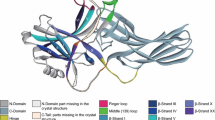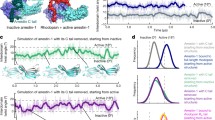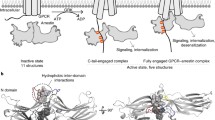Abstract
The idea that the conformation of the receptor-bound arrestin is dramatically different from that of a free arrestin in solution emerged soon after the discovery of the first member of the family, visual arrestin-1. However, most of the evidence for this emerged in the last few years from studies using biophysical methods and X-ray crystallography. The similarity of the conformational changes in different arrestin subtypes detected by various methods suggests that these rearrangements accompany arrestin “activation”, i.e., the transition into the high-affinity receptor-binding state. The key changes include the release of the arrestin C-terminal tail, the twisting of the two arrestin domains relative to each other, and the changes in several flexible loops in the central “crest” on the receptor-binding surface and elsewhere in the molecule. From a signaling standpoint, the changes on the arrestin side not involved in receptor contact appear more important, as they allow the non-receptor partners to discriminate between free and receptor-bound forms of arrestins. The identification of these changes facilitates elucidation of the structural basis of arrestin-mediated signaling, including mapping the binding sites for various signaling proteins.
Access this chapter
Tax calculation will be finalised at checkout
Purchases are for personal use only
Similar content being viewed by others
References
Altenbach C, Kusnetzow AK, Ernst OP, Hofmann KP, Hubbell WL (2008) High-resolution distance mapping in rhodopsin reveals the pattern of helix movement due to activation. Proc Natl Acad Sci U S A 105:7439–7444
Bayburt TH, Vishnivetskiy SA, McLean M, Morizumi T, Huang C-C, Tesmer JJ, Ernst OP, Sligar SG, Gurevich VV (2011) Rhodopsin monomer is sufficient for normal rhodopsin kinase (GRK1) phosphorylation and arrestin-1 binding. J Biol Chem 286:1420–1428
Benovic JL, Kuhn H, Weyand I, Codina J, Caron MG, Lefkowitz RJ (1987) Functional desensitization of the isolated beta-adrenergic receptor by the beta-adrenergic receptor kinase: potential role of an analog of the retinal protein arrestin (48-kDa protein). Proc Natl Acad Sci U S A 84:8879–8882
Choe HW, Kim YJ, Park JH, Morizumi T, Pai EF, Krauss N, Hofmann KP, Scheerer P, Ernst OP (2011) Crystal structure of metarhodopsin II. Nature 471:651–655
Feuerstein SE, Pulvermuller A, Hartmann R, Granzin J, Stoldt M, Henklein P, Ernst OP, Heck M, Willbold D, Koenig BW (2009) Helix formation in arrestin accompanies recognition of photoactivated rhodopsin. Biochemistry 48:10733–10742
Granzin J, Wilden U, Choe HW, Labahn J, Krafft B, Buldt G (1998) X-ray crystal structure of arrestin from bovine rod outer segments. Nature 391:918–921
Granzin J, Cousin A, Weirauch M, Schlesinger R, Büldt G, Batra-Safferling R (2012) Crystal structure of p44, a constitutively active splice variant of visual arrestin. J Mol Biol 416:611–618
Granzin J, Stadler A, Cousin A, Schlesinger R, Batra-Safferling R (2015) Structural evidence for the role of polar core residue Arg175 in arrestin activation. Sci Rep 5:15808
Gurevich VV (1998) The selectivity of visual arrestin for light-activated phosphorhodopsin is controlled by multiple nonredundant mechanisms. J Biol Chem 273:15501–15506
Gurevich VV, Benovic JL (1992) Cell-free expression of visual arrestin. Truncation mutagenesis identifies multiple domains involved in rhodopsin interaction. J Biol Chem 267:21919–21923
Gurevich VV, Benovic JL (1993) Visual arrestin interaction with rhodopsin: sequential multisite binding ensures strict selectivity towards light-activated phosphorylated rhodopsin. J Biol Chem 268:11628–11638
Gurevich VV, Benovic JL (1995) Visual arrestin binding to rhodopsin: diverse functional roles of positively charged residues within the phosphorylation-recognition region of arrestin. J Biol Chem 270:6010–6016
Gurevich VV, Benovic JL (1997) Mechanism of phosphorylation-recognition by visual arrestin and the transition of arrestin into a high affinity binding state. Mol Pharmacol 51:161–169
Gurevich VV, Gurevich EV (2004) The molecular acrobatics of arrestin activation. Trends Pharmacol Sci 25:105–111
Gurevich EV, Gurevich VV (2006a) Arrestins are ubiquitous regulators of cellular signaling pathways. Genome Biol 7:236
Gurevich VV, Gurevich EV (2006b) The structural basis of arrestin-mediated regulation of G protein-coupled receptors. Pharmacol Ther 110:465–502
Gurevich VV, Chen C-Y, Kim CM, Benovic JL (1994) Visual arrestin binding to rhodopsin: intramolecular interaction between the basic N-terminus and acidic C-terminus of arrestin may regulate binding selectivity. J Biol Chem 269:8721–8727
Han M, Gurevich VV, Vishnivetskiy SA, Sigler PB, Schubert C (2001) Crystal structure of beta-arrestin at 1.9 Å: possible mechanism of receptor binding and membrane translocation. Structure 9:869–880
Hanson SM, Francis DJ, Vishnivetskiy SA, Kolobova EA, Hubbell WL, Klug CS, Gurevich VV (2006) Differential interaction of spin-labeled arrestin with inactive and active phosphorhodopsin. Proc Natl Acad Sci U S A 103:4900–4905
Hanson SM, Cleghorn WM, Francis DJ, Vishnivetskiy SA, Raman D, Song X, Nair KS, Slepak VZ, Klug CS, Gurevich VV (2007a) Arrestin mobilizes signaling proteins to the cytoskeleton and redirects their activity. J Mol Biol
Hanson SM, Gurevich EV, Vishnivetskiy SA, Ahmed MR, Song X, Gurevich VV (2007b) Each rhodopsin molecule binds its own arrestin. Proc Natl Acad Sci U S A 104:3125–3128
Hanson SM, Van Eps N, Francis DJ, Altenbach C, Vishnivetskiy SA, Arshavsky VY, Klug CS, Hubbell WL, Gurevich VV (2007c) Structure and function of the visual arrestin oligomer. EMBO J 26:1726–1736
Hirsch JA, Schubert C, Gurevich VV, Sigler PB (1999) The 2.8 Å crystal structure of visual arrestin: a model for arrestin’s regulation. Cell 97:257–269
Hubbard R, St George RC (1958) The rhodopsin system of the squid. J Gen Physiol 41:501–528
Kang Y, Zhou XE, Gao X, He Y, Liu W, Ishchenko A, Barty A, White TA, Yefanov O, Han GW et al (2015) Crystal structure of rhodopsin bound to arrestin by femtosecond X-ray laser. Nature 523:561–567
Kim M, Vishnivetskiy SA, Van Eps N, Alexander NS, Cleghorn WM, Zhan X, Hanson SM, Morizumi T, Ernst OP, Meiler J et al (2012) Conformation of receptor-bound visual arrestin. Proc Natl Acad Sci U S A 109:18407–18412
Kim YJ, Hofmann KP, Ernst OP, Scheerer P, Choe HW, Sommer ME (2013) Crystal structure of pre-activated arrestin p44. Nature 497:142–146
Kovoor A, Celver J, Abdryashitov RI, Chavkin C, Gurevich VV (1999) Targeted construction of phosphorylation-independent b-arrestin mutants with constitutive activity in cells. J Biol Chem 274:6831–6834
Krupnick JG, Gurevich VV, Benovic JL (1997) Mechanism of quenching of phototransduction. Binding competition between arrestin and transducin for phosphorhodopsin. J Biol Chem 272:18125–18131
Kuhn H (1978) Light-regulated binding of rhodopsin kinase and other proteins to cattle photoreceptor membranes. Biochemistry 17:4389–4395
Kuhn H, Hall SW, Wilden U (1984) Light-induced binding of 48-kDa protein to photoreceptor membranes is highly enhanced by phosphorylation of rhodopsin. FEBS Lett 176:473–478
Lin FT, Krueger KM, Kendall HE, Daaka Y, Fredericks ZL, Pitcher JA, Lefkowitz RJ (1997) Clathrin-mediated endocytosis of the beta-adrenergic receptor is regulated by phosphorylation/dephosphorylation of beta-arrestin1. J Biol Chem 272:31051–31057
Lin FT, Chen W, Shenoy S, Cong M, Exum ST, Lefkowitz RJ (2002) Phosphorylation of beta-arrestin2 regulates its function in internalization of beta(2)-adrenergic receptors. Biochemistry 41:10692–10699
Lohse MJ, Benovic JL, Codina J, Caron MG, Lefkowitz RJ (1990) Beta-arrestin: a protein that regulates beta-adrenergic receptor function. Science 248:1547–1550
Lohse MJ, Andexinger S, Pitcher J, Trukawinski S, Codina J, Faure JP, Caron MG, Lefkowitz RJ (1992) Receptor-specific desensitization with purified proteins. Kinase dependence and receptor specificity of beta-arrestin and arrestin in the beta 2-adrenergic receptor and rhodopsin systems. J Biol Chem 267:8558–8564
Mayeenuddin LH, Mitchell J (2003) Squid visual arrestin: cDNA cloning and calcium-dependent phosphorylation by rhodopsin kinase (SQRK). J Neurochem 85:592–600
Milano SK, Pace HC, Kim YM, Brenner C, Benovic JL (2002) Scaffolding functions of arrestin-2 revealed by crystal structure and mutagenesis. Biochemistry 41:3321–3328
Modzelewska A, Filipek S, Palczewski K, Park PS (2006) Arrestin interaction with rhodopsin: conceptual models. Cell Biochem Biophys 46:1–15
Murakami M, Kouyama T (2008) Crystal structure of squid rhodopsin. Nature 453:363–367
Ohguro H, Yoshida N, Shindou H, Crabb JW, Palczewski K, Tsuda M (1998) Identification of a single phosphorylation site within octopus rhodopsin. Photochem Photobiol 68:824–828
Palczewski K, Buczyłko J, Imami NR, McDowell JH, Hargrave PA (1991a) Role of the carboxyl-terminal region of arrestin in binding to phosphorylated rhodopsin. J Biol Chem 266:15334–15339
Palczewski K, Pulvermuller A, Buczylko J, Hofmann KP (1991b) Phosphorylated rhodopsin and heparin induce similar conformational changes in arrestin. J Biol Chem 266:18649–18654
Peterhans C, Lally CC, Ostermaier MK, Sommer ME, Standfuss J (2016) Functional map of arrestin binding to phosphorylated opsin, with and without agonist. Sci Rep 6:28686
Pulvermuller A, Maretzki D, Rudnicka-Nawrot M, Smith WC, Palczewski K, Hofmann KP (1997) Functional differences in the interaction of arrestin and its splice variant, p44, with rhodopsin. Biochemistry 36:9253–9260
Rasmussen SG, DeVree BT, Zou Y, Kruse AC, Chung KY, Kobilka TS, Thian FS, Chae PS, Pardon E, Calinski D et al (2011) Crystal structure of the beta2 adrenergic receptor-Gs protein complex. Nature 477:549–555
Robinson KA (2015) Arrestin interactions with rhodopsin in the squid visual system. In: Graduate department of pharmacology and toxicology. University of Toronto
Robinson KA, Ou WL, Guan X, Sugamori KS, Bandyopadhyay A, Ernst OP, Mitchell J (2015) The effect of phosphorylation on arrestin-rhodopsin interaction in the squid visual system. J Neurochem 135:1129–1139
Ryba NJ, Findlay JB, Reid JD (1993) The molecular cloning of the squid (Loligo forbesi) visual Gq-alpha subunit and its expression in Saccharomyces cerevisiae. Biochem J 292(Pt 2):333–341
Schleicher A, Kuhn H, Hofmann KP (1989) Kinetics, binding constant, and activation energy of the 48-kDa protein-rhodopsin complex by extra-metarhodopsin II. Biochemistry 28:1770–1775
Shimamura T, Hiraki K, Takahashi N, Hori T, Ago H, Masuda K, Takio K, Ishiguro M, Miyano M (2008) Crystal structure of squid rhodopsin with intracellularly extended cytoplasmic region. J Biol Chem 283:17753–17756
Shukla AK, Manglik A, Kruse AC, Xiao K, Reis RI, Tseng WC, Staus DP, Hilger D, Uysal S, Huang LY et al (2013) Structure of active beta-arrestin-1 bound to a G-protein-coupled receptor phosphopeptide. Nature 497:137–141
Smith WC, Milam AH, Dugger D, Arendt A, Hargrave PA, Palczewski K (1994) A splice variant of arrestin. Molecular cloning and localization in bovine retina. J Biol Chem 269:15407–15410
Sommer ME, Smith WC, Farrens DL (2005) Dynamics of arrestin-rhodopsin interactions: arrestin and retinal release are directly linked events. J Biol Chem 280:6861–6871
Sommer ME, Hofmann KP, Heck M (2011) Arrestin-rhodopsin binding stoichiometry in isolated rod outer segment membranes depends on the percentage of activated receptors. J Biol Chem 286:7359–7369
Sutton RB, Vishnivetskiy SA, Robert J, Hanson SM, Raman D, Knox BE, Kono M, Navarro J, Gurevich VV (2005) Crystal structure of cone arrestin at 2.3 Å: evolution of receptor specificity. J Mol Biol 354:1069–1080
Swardfager W, Mitchell J (2007) Purification of visual arrestin from squid photoreceptors and characterization of arrestin interaction with rhodopsin and rhodopsin kinase. J Neurochem 101:223–231
Szczepek M, Beyriere F, Hofmann KP, Elgeti M, Kazmin R, Rose A, Bartl FJ, von Stetten D, Heck M, Sommer ME et al (2014) Crystal structure of a common GPCR-binding interface for G protein and arrestin. Nat Commun 5:4801
Vishnivetskiy SA, Paz CL, Schubert C, Hirsch JA, Sigler PB, Gurevich VV (1999) How does arrestin respond to the phosphorylated state of rhodopsin? J Biol Chem 274:11451–11454
Vishnivetskiy SA, Schubert C, Climaco GC, Gurevich YV, Velez M-G, Gurevich VV (2000) An additional phosphate-binding element in arrestin molecule: implications for the mechanism of arrestin activation. J Biol Chem 275:41049–41057
Vishnivetskiy SA, Hirsch JA, Velez M-G, Gurevich YV, Gurevich VV (2002) Transition of arrestin in the active receptor-binding state requires an extended interdomain hinge. J Biol Chem 277:43961–43968
Vishnivetskiy SA, Francis DJ, Van Eps N, Kim M, Hanson SM, Klug CS, Hubbell WL, Gurevich VV (2010) The role of arrestin alpha-helix I in receptor binding. J Mol Biol 395:42–54
Vishnivetskiy SA, Gimenez LE, Francis DJ, Hanson SM, Hubbell WL, Klug CS, Gurevich VV (2011) Few residues within an extensive binding interface drive receptor interaction and determine the specificity of arrestin proteins. J Biol Chem 286:24288–24299
Vishnivetskiy SA, Baameur F, Findley KR, Gurevich VV (2013) Critical role of the central 139-loop in stability and binding selectivity of arrestin-1. J Biol Chem 288:11741–11750
Wilden U (1995) Duration and amplitude of the light-induced cGMP hydrolysis in vertebrate photoreceptors are regulated by multiple phosphorylation of rhodopsin and by arrestin binding. Biochemistry 34:1446–1454
Wilden U, Hall SW, Kühn H (1986) Phosphodiesterase activation by photoexcited rhodopsin is quenched when rhodopsin is phosphorylated and binds the intrinsic 48-kDa protein of rod outer segments. Proc Natl Acad Sci U S A 83:1174–1178
Zhan X, Gimenez LE, Gurevich VV, Spiller BW (2011) Crystal structure of arrestin-3 reveals the basis of the difference in receptor binding between two non-visual arrestins. J Mol Biol 406:467–478
Zhuo Y, Vishnivetskiy SA, Zhan X, Gurevich VV, Klug CS (2014) Identification of receptor binding-induced conformational changes in non-visual arrestins. J Biol Chem 289:20991–21002
Acknowledgements
This work was supported by the NIH RO1 EY011500, GM109955, GM077561 (VVG), EY05216 and the Jules Stein Professorship Endowment (WLH), and Canada Excellence Research Chairs program (OPE). OPE is the Anne and Max Tanenbaum Chair at University of Toronto. We thank Dr. Ned Van Eps for comments on the manuscript.
Author information
Authors and Affiliations
Corresponding authors
Editor information
Editors and Affiliations
Rights and permissions
Copyright information
© 2017 Springer International Publishing AG
About this chapter
Cite this chapter
Bandyopadhyay, A., Zhuo, Y., Hubbell, W.L., Klug, C.S., Gurevich, V.V., Ernst, O.P. (2017). Active Conformations of Arrestins: Expected and Unexpected Changes. In: Gurevich, V. (eds) The Structural Basis of Arrestin Functions. Springer, Cham. https://doi.org/10.1007/978-3-319-57553-7_12
Download citation
DOI: https://doi.org/10.1007/978-3-319-57553-7_12
Published:
Publisher Name: Springer, Cham
Print ISBN: 978-3-319-57552-0
Online ISBN: 978-3-319-57553-7
eBook Packages: Biomedical and Life SciencesBiomedical and Life Sciences (R0)




